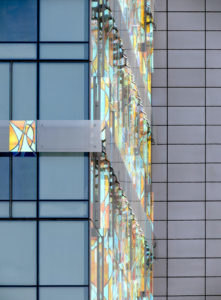将艺术与建筑融合来创造康复空间
Each is a form of creative expression and perspective. And each evokes an emotional response from an audience. But how do these two forms of expression come together to move audiences in a healthcare setting?
Architecture uses space and form to tell its story, while art has a poetry about its expression. Some might contend that architecture itself is art and that it is unnecessary to add an artist into the equation to make a design great. But I believe the fusion of artist and architect can lead to a synergistic solution that can, in turn, enrich the human experience. And this is especially important in healing environments.
Art plays an important role in lifting the spirit of the human experience. Whether viewed as part of a public installation or shared in an aficionado’s private collection, art has the innate ability to offer a spiritual uplift and a sense of calm. There are many building types that benefit from the inclusion of art. I believe that the integration of art into architecture–whether it be a city complex, office workspace, hospital, or public green space–elevates and enhances the built environment.
As a healthcare designer, I feel we have a responsibility to improve the lives of patients, family members, and staff through the buildings we create, and working with artists during the design process further energizes my passion for designing healthcare environments. In my experience, this fusion of passions and professions can inspire design solutions that positively affect the human condition and influence the healing process.
While not every project can incorporate art, it has been my experience that architects do not innately think to include an artist in the early stages of a project. Often, artists are given a place to embellish once a project is already designed and completed. Though this inclusion of art into a project may indeed add value, this is not the collaborative design model for which architects should strive but rather a collaborative design process.
The real fusion of art and architecture occurs when the two art forms come together to bring a design vision to a level that otherwise could not be achieved. I have explored the integration of art into architecture for over 20 years, but I was only recently able to achieve the results I’ve envisioned.
This achievement came with the University of California, San Francisco (UCSF) Benioff Children’s Hospital project. I was challenged to translate the client’s vision for what a children’s hospital set in San Francisco’s Mission Bay district should be. UCSF did not want a typical children’s hospital expressed in bright primary colors and kid-like forms. Instead, they coined the term “sophisticated whimsy” to describe their vision. And those words inspired in me the design concept of a kaleidoscope.
The kaleidoscope concept was further translated into an idea of ever-changing light and color, which continuously shifts and transforms, much like the experience of looking through this timeless children’s toy. I was challenged to find a way to capture that spirit within the hospital’s architecture.
The exterior of the children’s hospital presented the perfect opportunity to fuse art into the building’s architecture. Here, laminated glass panels of fritted and dichroic glass patterns were suspended out from the structure’s glass enclosure, providing a means to control the sun as it moved across the horizon. As the sun moves across the sky, the magic and poetry of light and color shift across the space throughout the day. Mitigating solar exposure glare and heat gain coupled with the concept of the kaleidoscope was the perfect synergy of expression that was not only practical and effective but allowed the art to be completely fused with the architecture.
By integrating an artist early on during conceptual planning and design, we were able to create a bit of magic that enhances the patient experience. We also carried this concept into the patient rooms, where ever-changing patterns of color and light provide a positive distraction and improves the healing process.
While UCSF Benioff Children’s Hospital stands out as my most significant example of fusing art into architecture, this philosophy is also woven into SmithGroupJJR projects which are currently in design. For example, the Adventist Health, Sonora Regional Medical Center Outpatient Pavilion integrates a custom-designed nature pattern into glazed panels as well as an artful installation of colored glass for both the donor and scripture wall in the lobby as a symbol of the healing power of water. The Kaiser Permanente Dublin Specialty Medical Office Building and Cancer Center integrates art into the façade as a public art feature that is more than 150 feet in length, reflecting the energetic mission of Kaiser’s Thrive campaign.
The successful fusion of art into architecture has given me an appreciation for the power of collaboration. I have seen firsthand an artist’s ability to take a design vision to levels unattainable by architect or artist alone. My personal goal is to continue to bring artists onto project teams from the conceptual onset. This collaboration will allow us to create new and exciting opportunities to fuse art into architecture. I am certain this will heighten both the art and architecture and, as a result, will enable me to continue to create places that heal.
In a recent Perspectives panel discussion, a panel of leading architects and artists explored the fusion of art and architecture and the many ways one can inspire the other. Challenges of the process were discussed, from conflicting design visions to technical constraints; tools and strategies were also shared, leaving those in attendance excited to embrace the collaborative synergy between architect and artist on future projects. In the clip above, Sam muses on how art can be used to positively impact a healthcare environment. You can replay the full discussion here. (©SmithGroupJJR 2016)
